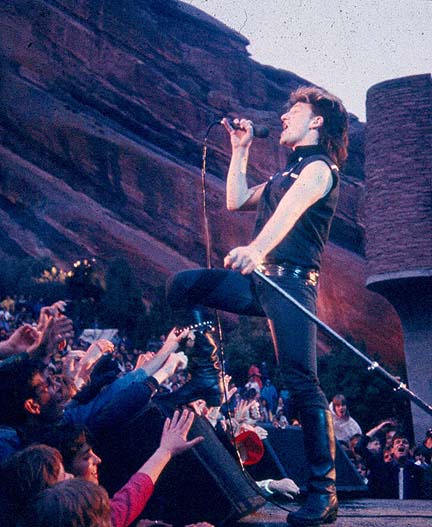On Tuesday A Look Back At U2’s ‘Under A Blood Red Sky’ 30 Years Later was a top story. Here is the recap: (Radio.com) Radio.com takes a look back at U2’s 1983 live EP, Under A Blood Red Sky, which celebrates its 30th anniversary. In 1983, to most of America, U2 was a Modern Rock band, capital “M,” capital “R.” With their heavy post-punk influences, they fit right in on that radio format with Tears For Fears, Talking Heads, David Bowie and Human League. They were known for a few MTV videos, mainly “New Year’s Day” from their War album, and “Two Hearts Beat As One” from their prior album, October. U2 may have had visions of world domination, but that ambition didn’t really translate to the American audience. They needed that audience to become a band on the level of their idols, the Who.
Most punk and post-punk groups of the ’80s had an anti-arena rock vibe to them, and were more comfortable in clubs; they all had to figure out how to translate their shows to larger venues. U2 had a unique problem: they were a stadium band waiting to actually get popular enough to play stadiums. Their message required a big stage, they just needed to get there.
Their June 5, 1983, concert at the Red Rocks Amphitheatre in Colorado was an important moment that connected their underground roots and their Springsteen-ian ambitions. They filmed the show for a “home video”, Live At Red Rocks; two of the songs from that would also be used for the Under A Blood Red Sky EP (which also included performances recorded in Boston and Germany). The two releases are often associated with each other, and the live video is included as a bonus disc in the 2008 Under A Blood Red Sky reissue. So, for the purposes of this article, we’ll discuss them together, as they were both a big part into exposing U2 to America as band more in the vein of Springsteen or the Who than the Cure or Joy Division.

The song from Live At Red Rocks that brought this point home was “Sunday Bloody Sunday,” which got a lot of play on MTV. It conveyed Bono’s power as a frontman in a way that music videos hadn’t. The clip was aided by the opening shot, which showed Bono’s serious looking profile surrounded by flames, while you heard his on-stage announcement, a phrase U2 fans would get used to over the decades: “This song is not a rebel song. This song is ‘Sunday Bloody Sunday.'” It sounded important. The band’s performance was Clash-like: in-your-face and political.
Red Rocks was the band’s biggest headlining show to date at that point: the amphitheater had a capacity of 7,000. As drummer Larry Mullen recalls in the 2006 oral history U2 By U2, “There was a lot of money riding on this, all the money we’d made from the tour, everything that was in the bank, basically.”
They weren’t leaving anything to chance. The band’s manager, Paul McGuinness had a background in film (having worked on a 1973 Sean Connery film called Zardoz), and knew that capturing a rock band’s performance entailed more than just pointing cameras in their direction. “It was crucial to have a real rock ‘n’ roll director and cameraman because the species did not exist in America. If you wanted a live video, you got a guy who shot football, and it looked like it.”
This was no small point. These performances didn’t look like a football game (American nor European). They looked like a tribal gathering. Credit Red Rocks’ natural beauty and the gigantic torches atop the theater. And the white flag waved by Bono. But some credit is also due to the director, Gavin Taylor, who shot Bono and Edge from below, making them seem like Rock Gods.
Then there was the weather. On a nice day, Red Rocks is one of the most beautiful venues in America. But on June 5, 1983, it was not a nice day. In fact, it rained so much that the concert’s promoter wanted to cancel. McGuinness and the band refused to do that; they had too much riding on the show. Financially, they had everything riding on the show and there would be no “rain date.” Happily, the weather cleared up somewhat, and the show took place after the rain passed, but a cloud of mist enveloped the venue. It gave the appearance that there was steam coming off of them during their furious performance. As The Edge said in U2 On U2, “It was like God’s dry ice.” However, the weather did deter many fans from attending the show and in fact Red Rocks was less than half-full. Again, credit the production team for shooting the audience in a way that made the place seem jam-packed.
Of course, if the band weren’t so powerful that night, none of the other factors would matter. As Anthony DeCurtis wrote in the liner notes to the Under A Blood Red Sky reissue, “What audiences learned from engaging with U2 in concert is that it is essential to care. One of the band’s great strengths is its willingness to provoke, and no one could leave one of the band’s shows without feeling energized, exercised and ready to tangle with the world to whatever end.” That’s what fans took away from both the live album and the home video. This wasn’t just a stop-gap release between albums (as, perhaps, Wide Awake In America was a few years later): it was showing potential fans something they may have missed.
Copyright 2013 U2 France / http://www.u2france.com/actu
Admin
Latest posts by Admin (see all)
- Apirl 2014 U2 Arrives - December 22, 2013
- ‘Ordinary Love’ Nominated for Critics’ Choice Award - December 19, 2013
- Sacred Stables, Sacred Stadiums: Lifting the Veil on “Zooropa” at Christmas - December 19, 2013



